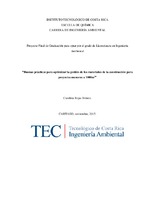Mostrar el registro sencillo del ítem
Buenas prácticas para optimizar la gestión de los materiales de la construcción para proyectos menores a 1000m2
| dc.contributor.author | Rojas-Brenes, Carolina | |
| dc.date.accessioned | 2017-09-12T17:10:55Z | |
| dc.date.available | 2017-09-12T17:10:55Z | |
| dc.date.issued | 2015 | |
| dc.identifier.uri | https://hdl.handle.net/2238/7388 | |
| dc.description | Proyecto de Graduación (Licenciatura en Ingeniería Ambiental) Instituto Tecnológico de Costa Rica, Escuela de Química, 2015. | es |
| dc.description.abstract | In Costa Rica, the construction sector is in constant growth. Despite the existing regulation for projects with areas greater than 1000m2, there is no accompaniment for small constructions. This study will generate good practices to be proposed in a national guide for construction material management for projects under 1000m2 made by micro, small and medium-sized enterprises. Through visits to construction projects, a survey and interviews involving the reasons reported in the literature, the perception of 43 designers and architects, and staff of five innovative companies was obtained, on the responsibility they possess in waste generation. These causes were previously validated by the Costa Rican Chamber of Construction. In addition, good practices applied in Costa Rica were collected, which were reinforced with different authors’ recommendations to optimize the use of construction materials. From the statistical treatment of the data three waste generation causes during the design process were validated by the architects surveyed: "not considering products made under the concept of modular coordination (blocks of concrete, roof laminate and doors and window frames)", "modifications to the original design during the construction process" and "not taking into account the geometry of different materials combination in the design process". In addition, all waste generation causes found were confirmed as a cause for at least one in five companies interviewed. As a result of this study, good practices are proposed to be considered for a national guide for construction material management, which have been collected in enterprises and in the existing literature. They have been organized according to the following processes: design, management, purchasing and procurement, materials management, execution of the work, waste and other activities. | es |
| dc.language.iso | spa | es |
| dc.publisher | Instituto Tecnológico de Costa Rica | es |
| dc.rights | acceso abierto | es |
| dc.subject | Causas generación residuos construcción | es |
| dc.subject | Residuos | es |
| dc.subject | Gestión materiales | es |
| dc.subject | Optimización | es |
| dc.title | Buenas prácticas para optimizar la gestión de los materiales de la construcción para proyectos menores a 1000m2 | es |
| dc.type | proyecto fin de carrera | es |


